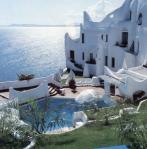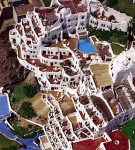It’s a beautiful Good Friday, and we’ve just returned from the Brazil trip, the last hoorah for Latin America Study Abroad-ers. We piled into the bus yesterday at about 11:30 a.m. to start the drive back, and we got in at about 9 this morning. Not the most pleasant of things, a 22-hour bus drive, but I still prefer it to flying.
The week was a non-stop action kind of thing, as we hopped borders back and forth between Brazil, Argentina and Paraguay every day. We had five big activities for the week.
The first was a trip to the Brazilian side of Iguaçu Falls. We stayed in Foz do Iguaçu, the entirely tourism-based town through which you get to the Brazilian National Park and visit the falls. Because of the way boundary lines are drawn between the countries, Brazil controls only something like 30% of the falls, but what they control is still awe-inspiring and beautiful. What you get on the Brazilian side is a panoramic view of the great cataratas. After a morning of lovely picture opportunities (I left my camera in my hotel room the first day! Ack! But my roommates and I woke up fifteen minutes after we were supposed to meet to leave for the falls, so I was more concerned about clothes), a group of us piled into a boat that sped up the river, up into the falls, and got us all completely, totally, thoroughly soaked as it drove straight under one of the waterfalls.
Also as part of that day, we went to the Parque do Aves (The Bird Park, which I had a difficult time enjoying, still soaking wet as I was), where we walked through rain forest enclosures with all the most beautiful kinds of birds that Brazil had to offer. The toucans were especially easy to get close to – they wouldn’t fly away, even if you came up and petted them, although they would most assuredly bite you if you tried.
ACU had sent a photo and video crew to the Casa to follow us, and they came with us for the first part of the Brazil trip, taking some really incredible footage. You can see some of what they took the first day on facebook here: http://www.new.facebook.com/notes.php?id=54606170&drafts#/video/video.php?v=541036716467&comments.
For dinner that night, we went to this huge buffet with a massive grill – as much of any kind of meat you wanted, cooked however you wanted it – and were treated to a show while we ate. The show included traditional dances from all the nearby countries, which was really fun.
The next morning, we crossed back in Argentina to visit their side of the falls, which I much preferred. They had walkways that took you right onto the waterfalls, so the water was rushing past you and the spray was coming up in your face (bad if you want to take pictures, fabulous if you want the waterfall experience). I actually did get some pictures taken that day, but I’m thoroughly disappointed in them. Iguaçu Falls is not something you can really capture within a viewfinder. I’ve never seen anything so beautiful or powerful in my life. Eleanor Roosevelt, when she visited these falls, exclaimed only, “Poor Niagara!”
The third day began with a visit to Itaipu Dam, the largest hydroelectric power plant in the world, which was created through a joint effort between Brazil and Paraguay. The dam, built on the Paraná River that divides the two countries, supplies 75% of Paraguay’s power and 25% of Brazil’s. :-O
We then traveled into Ciudad del Este, Paraguay, the knock-off capital of the Americas, where they sell everything from pirated DVDs to AK-47s to infants. I didn’t really enjoy it all that much, because I’m not in the market for a case of not-quite-legit iPhones or Puma attire. It was mostly just hot, and we wandered through street markets getting embarrassingly cheap American stuff shoved in our faces by pushy vendors for three hours before the group met up and headed back to Brazil again. In future travels, I will probably not be returning to Paraguay.
That night, though, was my favorite part of the trip. We hopped back over to the Argentina side of the falls for a delicious dinner at another nice buffet, and then we got on this little train that goes through the park, and it dropped us off in the middle of the forest for a moonlight hike back to la Garganta del Diablo, the walkway that went right up to the top of the falls. Everything was bleached to black and white by the moonlight, and moths floated like dust motes in the mist rising from the base of the falls. ¡Qué bonita! I’m sorry, but I took no pictures. This never would have transferred; it’s something you have to experience.
The next day was pretty much just a free day, and I slept in and then hung out watching movies in the hotel. What a great rest for mind and body! I needed it. 🙂
As always, I’ll be posting the pictures I took on Facebook, so check ’em out if you want to get a small, small sense of what this place was like.


